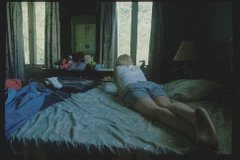I just finished reading The Museum, a play by Tina Howe. This is one of those works that could appeal to people on both sides of a very fractious divide. On the one hand, those people who are suspicious of, or unimpressed by so-called "conceptual art" could read this and feel vindicated. On the other, aesthetes enamored with said conceptual art could read it and have a good laugh at the philistines who schlep through galleries saying "My 5-year old kid could draw this."
The play is entertaining enough - lots of rapid-fire banter, a huge cast of walk-on characters. But by around page 40, I began to ask myself what, exactly, I was supposed to be getting from all this. Ironically enough, cue Chloe Trapp, a curator who enters with a patron to conduct a private tour. As she enters, she explains to the patron the significance of the pieces. All the other characters on stage are transfixed, and gather around the curator to hear more. "I'm so grateful!" the patron says. "Oh, we're all so grateful!" says another.
The play works because it's not really about conceptual art; it's about the difficulties of communicating across particular lines of difference - the tragic (but also comic) way in which we often seem to talk past each other. The museum is loud, cacophonous. The exhibit is titled "The Broken Silence." Language difference and disorder is a central theme here. My favorite scene is the final one, in which the deaf-mute parents of the artist Zachary Moe stand reverently in front of their son's paintings (canvases painted entirely white). Here is what they say to each other in sign language:
MRS. MOE. Remember the drawings he used to make as a child?
MR. MOE. The sketches he did of all his toys in his nursery...
MRS. MOE. How wonderful they were, bursting with life...
MR. MOE. Noisy with life!
MRS. MOE. Remember how he'd make the walls shake when he wanted something?
MR. MOE. And how they shook! He shouted with the voices of a thousand men!
Subscribe to:
Post Comments (Atom)







No comments:
Post a Comment